The Anaesthesia newsletter September 2021
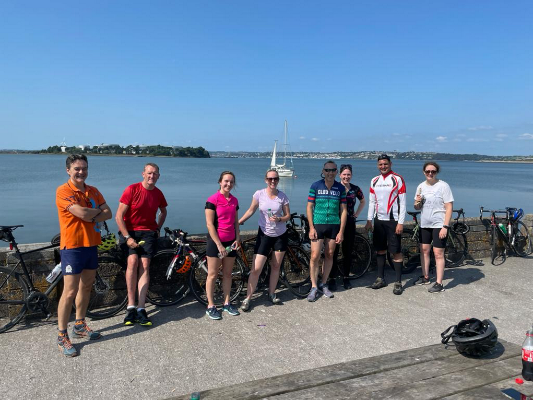
September UCC Anaesthesiology Newsletter- focus on Green Anaesthesia Week
Welcome to the September UCC Anaesthesiology Newsletter. We hope that this provides a platform where we can stay informed and connected across the UCC Anaesthesiology team and beyond. We wish to send a special greeting to our overseas readers, including those based in Australia and New Zealand (Aoife- I’m glad that the Tunnock Tea Cakes arrived safely- Eoin). We welcome contributions on clinical and academic topics, teambuilding and social outings, general interest, and updates from our diaspora. Please feel free to contact Dr Eoin O’Rathallaigh, SpR, CUH or myself at yesuccanews@gmail.com.
Dr Oonagh Hickey, Consultant Anaesthetist, CUH and co-editor.
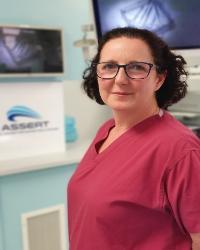
We are very grateful to Dr Dónall Ó’Cróinín (Chair, CAI Sustainability Committee and Consultant Anaesthesiologist, Mercy University Hospital) and Dr Tim Keady (CAI Sustainability Committee and Anaesthesia Clinical Fellow, Royal Papworth Hospital, UK) for their contributions to this newsletter. Both are passionate about sustainability and the environmental footprint of anaesthesiology. In the Spotlight Section, Dr Tim Keady outlines some of the challenges and invites us to register for the very first College of Anaesthesiologists of Ireland (CAI) Green Anaesthesia Week on-line conference where we can learn how to minimise our impact on the environment. In “Meet the Team”, Dr Dónall Ó’Cróinín reveals a little about what motivates him as a clinician and as an advocate for the environment- as well as revealing a roller coaster story that demands further enquiry.
We also find out about “The Most Dangerous Woman in America”- who was, naturally, from Cork. Her motto “Pray for the dead and fight like hell for the living” would serve as an appropriate battle cry for healthcare workers around the globe who have faced the current pandemic with courage, skill, and compassion.
Spotlight section:
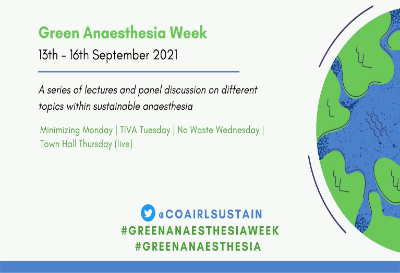
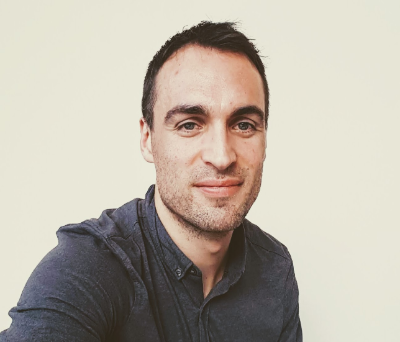
The Environmental Footprint of Anaesthesia
Dr Tim Keady, Anaesthesia Clinical Fellow, Royal Papworth Hospital, UK and CAI Sustainability Committee.
This letter was written by Dr Dónall O’Cróinín a UCC graduate, who works as a Consultant Anaesthesiologist in the Mercy University Hospital. It is being sent this week to all members of the College of Anaesthesiologists of Ireland (CAI) to coincide with the beginning of #GreenAnaesthesiaWeek.
Dear colleagues,
Decades after our careers have ended very significant quantities of the anaesthetic gases which we have administered to patients will still be in the atmosphere*. These super potent greenhouse gases will continue to overheat our planet long after we have gone *. Perhaps we do not reflect sufficiently on the long-term consequences of what we do every day. Our hopes, dreams and short-term desires can sometimes blind us from facing up to the reality of a particular situation. It appears that such is the case in humanity’s approach to the climate crisis and biodiversity collapse that are currently happening on planet Earth. We are in real trouble and have a relatively short period of time in which to mitigate the ongoing destruction of nature from human activity. Do not be blinded by the words, actions or in-actions of governments, organisations, and large parts of human society.
As anaesthesiologists, all of us have the potential to reduce by tonnes or even tens of tonnes the annual carbon footprint of our practices. As you will learn during green anaesthesia week such reductions will come from modifying our approaches to certain types of clinical cases. In order to determine the optimal path for patient care we must learn to incorporate the new clinical paradigm of ‘environmental footprint’ into the existing pillars of risk-benefit and cost-benefit analysis. What is the benefit in using anaesthetic techniques that contribute to the extinction of tens of thousands of species when they can be substituted with alternatives of much less environmental impact?
If humanity’s goal was to transform our paradise planet into a hell, we have made a very good start. Look at the droughts in Africa. Look at the fires in Australia, California and Greece. Look at the increasing ferocity of the hurricane season in North America and the Caribbean. Look at the floods in Western Europe. Look at the mass displacement of populations by failing rains in Southeast Asia. Look at the melting polar icecaps. Look at the starving polar bears and collapsing pollinator populations. Look at the heat waves cooking fruit on trees and roasting the exposed shellfish at low tide. There is undoubtedly a problem, but we can personally contribute to the solution every day in the way we practice anaesthesiology. You can make a difference. Log on to our webcasts and learn how to become part of a more sustainable healthcare future. The best kind of hope is the hope you grow yourself. Plant some seeds today.
Is mise le meas,
Dónall Ó’Cróinín
Chair, Sustainability Committee,
College of Anaesthesiologists of Ireland.
*N2O has an atmospheric half-life of 114 years.
In 2013, as a fresh young UCC graduate myself, while I was toiling as a surgical intern in the Mercy, I met Dónall, and he inspired me to go into Anaesthesia. In 2019 Dónall and another anaesthesiologist and UCC graduate Dr Oscar Duffy wrote a letter to the CAI calling for action on climate change. Together they inspired the formation of the colleges first Sustainability Committee. A lot has been achieved in a short time, but we are on the clock.
Dr Gillian O’Keeffe (another UCC graduate and anaesthesia trainee representative) and I have coordinated the creation of a week of lectures and debate on the environmental footprint of anaesthesia. Healthcare has an enormous carbon footprint globally – it’s twice that of the entire aviation industry. Anaesthesia is a disproportionate contributor, and the International Panel on Climate Change report has just signalled a code red for human driven global heating.
We would love for you to join us this September 13-16th. Learn about how in one swift move the carbon footprint from anaesthetic gases in Galway was reduced by perhaps 80%. Learn about how to use intravenous alternatives to gaseous anaesthesia. Learn about how the cost of environmental inaction must now be considered in legislation at an EU level. Learn how hospitals in New Zealand and the UK and reduced their environmental footprints, so that we can walk in their footsteps.
But more importantly participate in the debate, share your concerns, discuss environmentally friendly anaesthesia with your peers, mentors, and patients. #GreenAnaesthesiaWeek is a great place to start, with short presentations available on demand each day at from Monday 13th to Wednesday 15th September and a live virtual town hall discussion on Thursday September 16th at 19:00. For more information please find us on twitter @COAIrlsustain, log onto www.anaesthesia.ie or refer to the flyer at the end of the newsletter.
Meet the team:
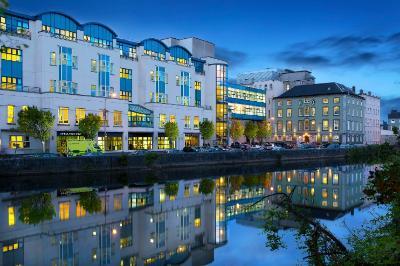
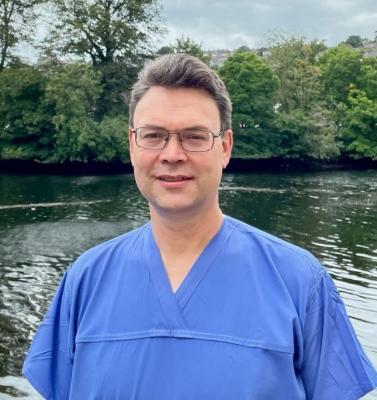
Dónall Ó’Cróinín, Consultant Anaesthesiologist Mercy University Hospital and Chair of the Sustainability Committee, College of Anaesthesiologists of Ireland.
- What, or even who, lead you to choose anaesthesia as a career? Anaesthesiology seemed a good way to always be involved with what seemed the most interesting and exciting parts of medicine combined with what seemed like a decent chance of getting a consultant post at the end of training.
- If you were to choose another medical specialty, what would it be? Microbiology
- What book or film would you recommend to a young doctor? The Doomsday Machine by Daniel Ellsberg
- Tell us something surprising about yourself? To quote GW Bush, when I was young and foolish, I was young and foolish. For one summer job I test rode a newly constructed rollercoaster strapped in with crash test dummies in the other seats and an ambulance on standby.
- What would be your ideal weekend or holiday? My fantasy holiday would be to travel back in time and see what this planet was like before humans started to destroy its biosphere and drive into extinction so many irreplaceable species. I would really like to see a live dodo.
- If you could go back five or ten years and give yourself advice, what would it be? Buy as many bitcoin as you can
- Is there anyone you regard as your idol or hero? Greta Thunberg
- What ability, gift, or even superpower, would you most like to have? I would love the superpower to instantly restore our planet’s atmosphere to the condition it was in 250 years ago.
PNB updates:
We congratulate Dr Brian O’Donnell, Consultant Anaesthesiologist, CUH, on the publication of “Standardizing nomenclature in regional anaesthesia: an ASRA-ESRA Delphi consensus study of the abdominal wall, paraspinal, and chest wall blocks” in Regional Anaesthesia and Pain Medicine, BMJ recently. Dr O’Donnell was part of an international consensus panel of regional anaesthesiologists formed to standardise fascial plane block descriptive nomenclature. Both the European and American Societies of Regional Anaesthesia (ESRA, ASRA) endorsed and supported this body of work. The importance of standardised descriptive nomenclature cannot be understated, as it permits accurate communication in clinical practice, education and research.
Recent publications:
- Anesthetic considerations in Alstrom Syndrome: a case report. Aslam MZ, O’Meaghair A, O’Donnell B, 1-3, (7); 15, July 2021, Anaesthesia and Analgesia Practice.
- Determination of the initial minimum effective dose of 0.5% bupivacaine with 20 μg of fentanyl for an operative fixation of fractured neck of femur: a prospective, observational trial. Hitka T, O'Sullivan J, Szucs S, Iohom G. Minerva Anestesiol 2021; 87: 766-773.
- Effects of local anaesthetic dilution on the characteristics of ultrasound guided axillary brachial plexus block: a randomised controlled study. Ranganath A, Ahmed O, Iohom G. Med Ultrason 2021 Jul 1. doi: 10.11152/mu-3069. Online ahead of print.
Social activities:
Club Velo:
Dr Frank Loughnane, Consultant Anaesthesiologist, CUH
August 29 brought Club Velo to Ballycotton, the home of seafood, lighthouse and RNLI lifeboat, on its most recent intrepid adventure. This was the second outing since the changeover of trainee doctors in July and we had 10 cyclists on the road. We were joined by Kim O’Brien, sporting a new set of wheels, who travelled from Limerick to be with us once again and Dan Mullane from the Bon Secours Hospital.
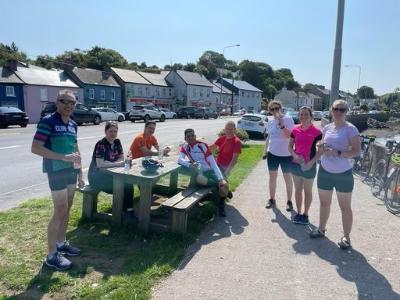
The route took us from Ballycotton to Whitegate along a coastal route and back somewhat inland through Cloyne to Ballycotton. All told, the route extended to approximately 42 kilometers made effortless by the spectacular sunshine we enjoyed for the day.
Compulsory coffee breaks were taken approximately every 10k, the most notable being at a food truck overlooking Ballybranigan beach. A 10-minute trek along the beach revealed the truck on an overlooking cliff top. Whitegate proved to be a little gem of a village and is host to the wonderfully named GoGo Grills!
Finally, we did make it back to Ballycotton where great servings of ‘Fish & Chips’ were had by all still basking in glorious sunshine.
The AAGBI Coffee and a Gas initiative:
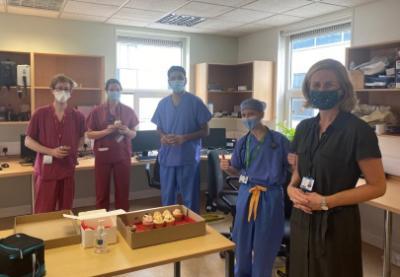
On the 8th September, the CUH Anaesthesiology Department enjoyed a socially distanced Coffee and a Gas (temporarily renamed “Buns on the Run”).
The selection of cupcakes from The Cupcake Cottage were a very welcome treat (I can personally recommend the raspberry ones- Ed.).
Good news:
Dr Aaron Blake, SAT, CUH
3 babies and a wedding!
The Department of Anaesthesiology, CUH, is absolutely delighted to congratulate not 1, not 2, but THREE of our current members/alumni on significant life events!
Firstly, we congratulate former rota-maker superstar and current CUH Regional Anaesthesia Fellow, Dr. Murray Connolly and his fiancée Hayley on the birth of their twin daughters - Aisling and Eimear!
Secondly, Congratulations to alumni staff Registrar Dr Danial Hussain on the recent birth of his baby Ali!
That's 3 future fantastic anaesthetists in the making.
Finally, a shoutout to senior SpR Dr John O'Connell who recently tied the knot! Not an easy feat during COVID times and we wish them all the best for the future.
Cool Corkonians:
The most dangerous woman in America,
“Pray for the dead and fight like hell for the living”
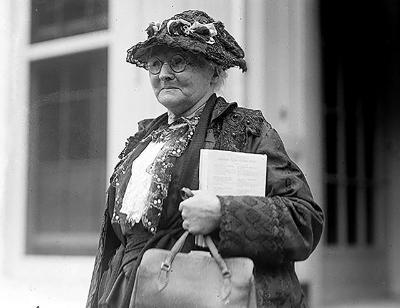
Mary Harris, also known as Mother Jones, was born in Cork City in 1837 but her family were forced to emigrate during the famine. In 1867 she lost her husband and their four children to yellow fever. She set up a dressmaking business but in 1871 she lost her home and business in the Great Chicago Fire. Moved by the poverty around her, she became actively involved in trade unions and began to organise strikes, demanding better pay and working conditions. She was a gifted speaker and become known as “the miners angel”. This made her unpopular with those in authority. She was described by a District Attorney as “the most dangerous woman in America… she comes into a state where peace and prosperity reign.. crooks her finger.. twenty thousand contented men lay down their tools and walk out”.
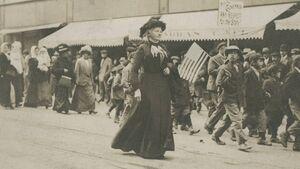
Apparently, she embraced her persona of “the grandmother of all agitators” and wore old fashioned clothes, claiming to be older than she was. Her words “pray for the dead and fight like hell for the living” are still used today by trade unions.
Festivals celebrating this firebrand have been held in Cork City, and a flea-market off McCurtain Street carries her name.
Editors:
Dr Eoin O’Rathallaigh, SpR, CUH, Dr Oonagh Hickey, Consultant Anaesthetist, CUH
